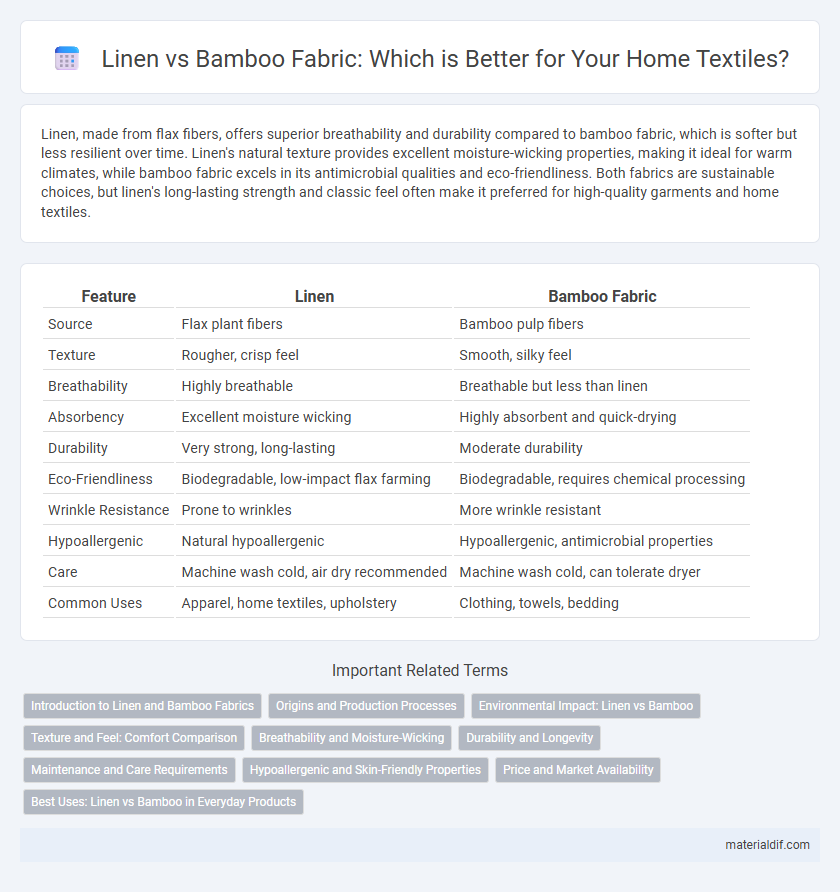Linen, made from flax fibers, offers superior breathability and durability compared to bamboo fabric, which is softer but less resilient over time. Linen's natural texture provides excellent moisture-wicking properties, making it ideal for warm climates, while bamboo fabric excels in its antimicrobial qualities and eco-friendliness. Both fabrics are sustainable choices, but linen's long-lasting strength and classic feel often make it preferred for high-quality garments and home textiles.
Table of Comparison
| Feature | Linen | Bamboo Fabric |
|---|---|---|
| Source | Flax plant fibers | Bamboo pulp fibers |
| Texture | Rougher, crisp feel | Smooth, silky feel |
| Breathability | Highly breathable | Breathable but less than linen |
| Absorbency | Excellent moisture wicking | Highly absorbent and quick-drying |
| Durability | Very strong, long-lasting | Moderate durability |
| Eco-Friendliness | Biodegradable, low-impact flax farming | Biodegradable, requires chemical processing |
| Wrinkle Resistance | Prone to wrinkles | More wrinkle resistant |
| Hypoallergenic | Natural hypoallergenic | Hypoallergenic, antimicrobial properties |
| Care | Machine wash cold, air dry recommended | Machine wash cold, can tolerate dryer |
| Common Uses | Apparel, home textiles, upholstery | Clothing, towels, bedding |
Introduction to Linen and Bamboo Fabrics
Linen fabric, derived from the flax plant, is renowned for its durability, breathability, and natural texture, making it a popular choice for warm-weather clothing and home textiles. Bamboo fabric, sourced from bamboo pulp, offers a silky softness, moisture-wicking properties, and inherent antibacterial qualities, appealing to eco-conscious consumers seeking sustainable alternatives. Both fabrics stand out in the textile industry for their renewable origins and unique performance characteristics.
Origins and Production Processes
Linen fabric is derived from the flax plant, primarily cultivated in Europe, and involves harvesting, retting, and rettling processes to extract fibers from the stalks. Bamboo fabric originates from the bamboo grass, mainly grown in China and Southeast Asia, and undergoes mechanical crushing or chemical processing to convert the fibers into textile material. While linen production emphasizes natural fiber extraction with minimal chemical use, bamboo fabric often requires intensive chemical treatments to produce soft, wearable textiles.
Environmental Impact: Linen vs Bamboo
Linen fabric, derived from flax plants, is highly sustainable due to its low water usage and minimal pesticide requirement compared to bamboo, which often involves chemical-intensive processing to transform bamboo pulp into fabric. The production of linen emits significantly fewer greenhouse gases and relies on natural fibers that biodegrade quickly, while bamboo fabric manufacturing can release harmful chemicals affecting soil and water quality. Choosing linen over bamboo fabric supports eco-friendly textiles by reducing environmental pollution and conserving natural resources.
Texture and Feel: Comfort Comparison
Linen fabric features a crisp, textured feel with natural breathability, making it cool and comfortable in hot weather, while bamboo fabric offers a softer, smoother texture with a silky touch that feels gentle against the skin. Linen's tactile roughness enhances durability and moisture-wicking properties, whereas bamboo excels in hypoallergenic comfort with excellent moisture absorption and softness. Both fabrics provide comfort but cater to different preferences: linen for a structured, airy feel and bamboo for a plush, luxuriously soft experience.
Breathability and Moisture-Wicking
Linen fabric exhibits superior breathability compared to bamboo, allowing air to circulate freely and keeping the wearer cool in hot climates. Its natural moisture-wicking properties efficiently draw sweat away from the skin, promoting faster evaporation and enhanced comfort. Bamboo, while also breathable, tends to retain more moisture, making linen the preferred choice for optimal dryness and ventilation.
Durability and Longevity
Linen fabric, made from flax fibers, is renowned for its exceptional durability and strength, often lasting significantly longer than bamboo fabric which is softer but less resilient. Linen's natural fiber structure resists wear and tear, making it ideal for items requiring long-term use such as upholstery and bedding. Bamboo fabric, while eco-friendly and moisture-wicking, tends to break down more quickly under repeated washing and heavy use compared to the robust longevity of linen.
Maintenance and Care Requirements
Linen fabric requires gentle washing with mild detergents and air drying to maintain its natural texture and prevent shrinkage. Bamboo fabric is more resistant to wrinkles and stains, allowing for easier machine washing and faster drying times. Both fabrics benefit from avoiding high heat and bleach to preserve their fibers and longevity.
Hypoallergenic and Skin-Friendly Properties
Linen fabric is naturally hypoallergenic due to its moisture-wicking and breathable fibers, making it ideal for sensitive skin and reducing irritation risks. Bamboo fabric also offers hypoallergenic properties, often praised for its softness and antibacterial qualities that help prevent skin allergies. Both fabrics support healthy skin but linen's coarser texture may benefit those seeking durability alongside skin-friendly comfort.
Price and Market Availability
Linen fabric generally commands a higher price than bamboo fabric due to its labor-intensive production and premium quality perception in the textile market. Bamboo fabric offers greater market availability at lower prices, driven by efficient processing techniques and increasing consumer demand for sustainable alternatives. Both fabrics have distinct positioning, with linen favored for luxury applications and bamboo valued for affordability and eco-friendliness.
Best Uses: Linen vs Bamboo in Everyday Products
Linen excels in breathability and durability, making it ideal for summer clothing, bed linens, and upholstery where moisture-wicking and strength are crucial. Bamboo fabric offers exceptional softness and natural antibacterial properties, perfect for activewear, towels, and baby clothing that require gentle and hygienic materials. Both fabrics suit sustainable fashion, but linen's rugged texture suits home goods, while bamboo's silky feel enhances personal care textiles.
Linen vs Bamboo Fabric Infographic

 materialdif.com
materialdif.com